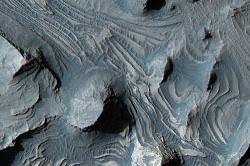Mission planners for the Mars Science Laboratory have quite a challenge on their hands. Where should they land the rover in 2010? They’ve got a whole planet to choose from. Well, they’ve narrowed the field of prospective landing sites down to about 30 intriguing candidates. And now NASA’s Mars Reconnaissance Orbiter has delivered high resolution images of each and every potential landing site… in colour!
We’ve got Spirit and Opportunity currently crawling across the surface of Mars. The Phoenix Mars Lander is on its way now. But when NASA’s Mars Science Laboratory arrives in 2010, the science is really going to get rolling. This SUV-sized robotic explorer will bring its own nuclear power source, and a suite of science instruments, giving it the range and capabilities to find life on the surface of the Red Planet.
But where should it land? The University of Arizona’s HiRISE team delivered 143 images captured by NASA’s Mars Reconnaissance Orbiter to the researchers this week, showcasing each location in false and enhanced colour.
Normally the spacecraft captures its images in black-and-white. It’s relatively simple to grab a single image of the Martian surface with one of its filters. When you’re trying to get colour, though, things become more complicated. The spacecraft moves so quickly above Mars that it’s very difficult to capture several images of the same area in different wavelengths of light and then merge them together into a single colour image.
Researchers with the HiRISE team have developed a computer program that can process data from different colour filters and merge them into a single image. Of course, to process each 20,000 by 50,000 pixel region can take several hours.
Mission planners for the Mars Science Laboratory will be meeting at a workshop later this month to try and narrow down the field of choices. These colour photographs will help them make a decision.
You can browse all the images yourself if you like. Click here to see them. You can also access the movie that pans across a potential landing site at Nili Fossae. The animation shows a range of enhanced colours that reveal rocks that might have been altered by water in the past.
Original Source: UA News Release

